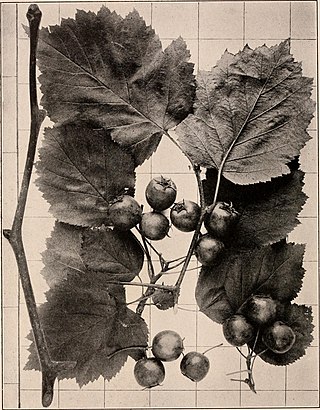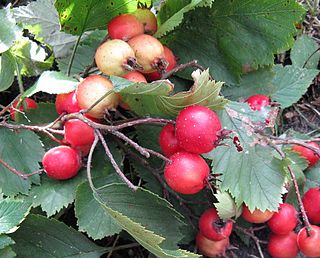
Mayhaw is the name given to the fruit of the species of Crataegus series Aestivales that are common in wetlands throughout the southern United States. The principal species are C. aestivalis, the eastern mayhaw, and C. opaca, the western mayhaw.

Crataegus mollis, known as downy hawthorn or red hawthorn, is a species of plant that occurs in eastern North America from southeastern North Dakota east to Nova Scotia and southwest to eastern Texas. The range of this species is from southern Ontario and Michigan to eastern North Dakota and southward to Denison, Texas, and Arizona. This tree inhabits wooded bottomlands, the prairie border, and the midwest savanna understorey.

Crataegus aestivalis, known as the eastern mayhaw, is a shrub or small tree of the southeastern United States that grows in low-lying or wet areas from eastern Alabama to central Florida and Virginia. It is one of several species of hawthorn with fruits known as "mayhaws", which are harvested for use in making mayhaw jelly, considered a delicacy in many areas of the South. Other species of mayhaws include Crataegus opaca, the western May Hawthorn, which is native from east Texas to Alabama.

Crataegus crus-galli is a species of hawthorn known by the common names cockspur hawthorn and cockspur thorn. It is native to eastern North America from Ontario to Texas to Florida, and it is widely used in horticulture. It is thought to be the parent, along with Crataegus succulenta, of the tetraploid species Crataegus persimilis.

Crataegus ellwangeriana is a named hawthorn species that has been poorly understood and often misidentified. It is now considered to be a synonym of C. coccinea var. coccinea. A study concluded, that C. pennsylvanica of series Molles has frequently been misidentified as C. ellwangeriana.

Crataegus macrosperma, the bigfruit hawthorn is a species of hawthorn native to most of the eastern United States and adjacent Canada, though uncommon at lower altitudes in the south. It is sometimes misidentified as C. flabellata. It is one of the earliest hawthorns to bloom in spring.

Crataegus marshallii is a species of hawthorn known by the common name parsley hawthorn. It is native to the southeastern United States.
Crataegus putnamiana is a rare species of North American hawthorn derived from hybridization between a species in Crataegus series Coccineae and a species in series Dilatatae.

Crataegus submollis, known as the northern downy hawthorn, northern red haw, Quebec hawthorn, or hairy cockspurthorn, is a species of hawthorn that grows to about 7 m in height and typically carries large crops of red fruit.

Crataegus wattiana, the Altai hawthorn, is an Asian species of hawthorn. The original description states that it has yellow fruit with five stones (pyrenes). Crataegus wattiana var. wattiana has become naturalized in Seattle, in the U.S. state of Washington.
Crataegus iracunda, with common name passionate hawthorn, and sometimes called the stolon-bearing hawthorn is a North American species of hawthorn. It was described in 1899 by Chauncey Delos Beadle of the Biltmore Herbarium in North Carolina. Taxonomic opinions have differed about this species, and to complicate matters Crataegus macrosperma and various species of C. series Populneae have frequently been misidentified as C. iracunda, leading to differing statements about its geographic range. The 2015 Flora of North America considers its range to be in the southeastern U.S., restricted to the US states of Alabama, Georgia, Louisiana, Mississippi, North Carolina, South Carolina, and Virginia.
Crataegus visenda is a species of hawthorn from the southeastern United States, in Alabama, Florida, and Georgia. It is a large shrub or small tree to 10 m tall. It has been considered as a synonym of Crataegus flava Aiton
Crataegus texana, the Texas hawthorn, is a member of the family Rosaceae. Typically, it is found in the form of a small tree or a large shrub and blooms in early spring, usually in the months of March and April. Flowers of the Texas Hawthorn are white and usually produce small, one-inch, scarlet fruits that are said to resemble tiny red apples. Its twigs are usually armed with thorns that can grow to be about one to three inches long.

Crataegus pennsylvanica, known as the Pennsylvania thorn, is a species of hawthorn native to Delaware, New York, North Carolina, Ontario, Ohio, and Pennsylvania, that grows to about 8 m in height. The mature trees have few thorns.
Series Populneae is a series within the genus Crataegus that contains at least eight species of hawthorn trees and shrubs, native to Eastern North America. Only one species, C. populnea is widespread.

Section Coccineae is a section within the genus Crataegus that includes the majority of North American hawthorn diversity. It includes at least 20 series as well as some species that have not yet been assigned to series.
Series Pruinosae is a series within the genus Crataegus that contains at least six species of hawthorn trees and shrubs, native to Eastern North America. They are similar in some respects to series Intricatae. They are very thorny, with medium to large leaves, and hard fruit that are usually pinkish in colour.

Series Tenuifoliae is a series within the genus Crataegus that contains at least seven species of hawthorn trees and shrubs, native to Eastern North America, with one disjunct species in the mountains of New Mexico.

Section Douglasia is a North American section within the genus Crataegus of species with black fruit.

Section Sanguineae is a section within the genus Crataegus native to central and eastern Europe and parts of Asia. It includes about 20 species and three series.












